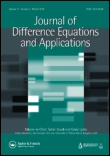
JOURNAL OF DIFFERENCE EQUATIONS AND APPLICATIONS
Scope & Guideline
Pioneering research in difference equations and their real-world impact.
Introduction
Aims and Scopes
- Theoretical Developments in Difference Equations:
The journal emphasizes the mathematical theory surrounding difference equations, including stability analysis, bifurcation theory, and qualitative behavior of solutions. - Applications in Mathematical Modeling:
There is a strong focus on applying difference equations to model real-world phenomena, including population dynamics, epidemic spread, and ecological interactions. - Numerical Methods and Analysis:
Research on numerical methods for solving difference equations is prevalent, including the development of innovative finite difference schemes and error analysis. - Dynamical Systems and Chaos Theory:
The journal explores the connections between difference equations and dynamical systems, including studies on chaos, bifurcations, and attractors. - Polynomial and Special Functions:
The exploration of special functions, orthogonal polynomials, and their applications in solving difference equations is a recurring theme.
Trending and Emerging
- Epidemiological Modeling Using Difference Equations:
Recent publications indicate an increasing trend in using difference equations to model epidemic dynamics, particularly in the context of COVID-19 and other infectious diseases. - Nonlinear Dynamics and Chaos:
There is a burgeoning interest in nonlinear dynamical systems and chaos theory, with researchers exploring complex behaviors and bifurcation phenomena in various models. - Interdisciplinary Applications:
Emerging themes include interdisciplinary applications of difference equations in fields such as ecology, economics, and engineering, highlighting the versatility of mathematical modeling. - Advanced Numerical Methods:
Innovative numerical techniques for solving complex difference equations are increasingly being explored, with a focus on enhancing accuracy and computational efficiency. - Stochastic and Random Dynamics:
The incorporation of stochastic elements into difference equations is a growing area of interest, reflecting a trend towards modeling uncertainty and randomness in dynamical systems.
Declining or Waning
- Classical Theories of Linear Difference Equations:
While foundational theories continue to be relevant, there has been a noticeable decrease in publications focused solely on classical linear difference equations as attention shifts towards more complex models and applications. - Basic Stochastic Difference Equations:
Research on basic stochastic models using difference equations appears to be decreasing, likely due to the growing complexity of models that incorporate more sophisticated stochastic processes. - Static Models without Dynamic Interactions:
There is a reduced emphasis on static models that do not account for dynamic interactions, as researchers increasingly focus on systems that involve feedback loops and evolving variables.
Similar Journals
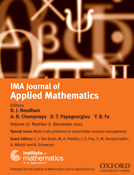
IMA JOURNAL OF APPLIED MATHEMATICS
Unveiling Real-World Applications of Mathematical ScienceThe IMA Journal of Applied Mathematics, published by Oxford University Press, serves as a pivotal platform for disseminating innovative research in the field of applied mathematics. With its ISSN 0272-4960 and E-ISSN 1464-3634, the journal has established itself as an essential resource for academics and practitioners, showing notable engagement with both theoretical and practical aspects of mathematics. Spanning over five decades since its inception in 1965, the journal covers a broad range of topics aimed at addressing complex real-world problems through mathematical modeling and computational techniques. Holding a Q3 quartile ranking in the applied mathematics category for 2023, and a Scopus rank of #310 out of 635, it plays a significant role in contributing to the academic discourse within this dynamic field. Despite not being open access, the journal's robust reputation and commitment to rigorous peer review ensure that cutting-edge research remains accessible to its audience of researchers, professionals, and students dedicated to advancing mathematical sciences. Its ongoing commitment to exceptional scholarship makes the IMA Journal of Applied Mathematics a vital resource for those seeking to explore and apply mathematical principles in various contexts.

ZEITSCHRIFT FUR ANGEWANDTE MATHEMATIK UND PHYSIK
Transforming Ideas into Solutions Through Rigorous ResearchZEITSCHRIFT FUR ANGEWANDTE MATHEMATIK UND PHYSIK, published by Springer International Publishing AG, is a leading journal in the fields of applied mathematics and physics, highly regarded as evidenced by its prestigious Q1 rankings in 2023 across multiple categories, including Applied Mathematics, Mathematics (miscellaneous), and Physics and Astronomy (miscellaneous). With an ISSN of 0044-2275 and an E-ISSN of 1420-9039, this journal covers a broad spectrum of research from theoretical frameworks to practical applications, making it an indispensable resource for researchers, professionals, and students alike. With converged years running from 1950 to 2024, it offers a rich history of contributions to the scientific community and remains vital for current advancements in mathematics and physics. While not an open-access journal, its subscription model ensures high-quality, peer-reviewed content that fosters innovation and collaboration across disciplines. The journal is conveniently located in Cham, Switzerland, providing a central hub for global research dissemination in these critical areas of study.

NONLINEAR ANALYSIS-REAL WORLD APPLICATIONS
Empowering Interdisciplinary Research in Nonlinear AnalysisNONLINEAR ANALYSIS-REAL WORLD APPLICATIONS, published by PERGAMON-ELSEVIER SCIENCE LTD, is a premier academic journal dedicated to advancing the field of nonlinear analysis through rigorous research and practical applications. With an impressive impact factor and categorized in the Q1 quartile across multiple disciplines including applied mathematics, computational mathematics, and engineering, this journal stands as a vital resource for researchers, professionals, and students. Its extensive scope encompasses significant contributions from the domains of economics, medicine, and various engineering fields, making it a leading platform for interdisciplinary exchange. The journal's commitment to showcasing innovative methodologies and solutions from 2000 to 2025 not only enhances its academic prestige but also fosters real-world impact, thus catering to a diverse scholarly audience eager to explore the complexities and potentials of nonlinear phenomena. Access options vary, ensuring a wide dissemination of knowledge to drive future discoveries in this dynamic area of study.
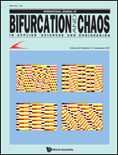
INTERNATIONAL JOURNAL OF BIFURCATION AND CHAOS
Connecting Disciplines Through Bifurcation InsightsINTERNATIONAL JOURNAL OF BIFURCATION AND CHAOS is a premier scholarly publication renowned for its focus on the intricate dynamics of bifurcation and chaotic systems across various scientific disciplines. Established in 1996 and published by World Scientific Publishing Co Pte Ltd, this journal plays a significant role in fostering interdisciplinary research within the realms of applied mathematics, engineering, and modeling & simulation, boasting impressive quartile rankings of Q1 in Multidisciplinary studies and Q2 across other key categories as of 2023. With an active convergence of cutting-edge research and comprehensive reviews, this journal engages with the academic community by providing a platform for novel findings and theoretical advancements. Researchers, professionals, and students alike will benefit from its rich content, reflecting the ever-evolving landscape of complexity science. Access to the journal is subscription-based, ensuring a curated selection of high-impact articles that adhere to the highest standards of academic excellence.
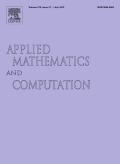
APPLIED MATHEMATICS AND COMPUTATION
Transforming Complex Problems into Mathematical SolutionsApplied Mathematics and Computation is a premier journal dedicated to the dissemination of high-quality research in the field of applied mathematics and computational methods. Published by Elsevier Science Inc, this influential journal has established itself as a key resource for researchers, professionals, and students interested in mathematical modeling, numerical analysis, computational algorithms, and their applications across various disciplines. With an impressive impact factor reflecting its scholarly credibility, it holds a distinguished position in the Q1 quartile for both applied and computational mathematics as of 2023, ranking #31/635 and #12/189 in Scopus categories respectively, thereby indicating its significant impact on the academic community. The journal encompasses a broad spectrum of topics, encouraging original research, critical reviews, and innovative methodologies that address real-world challenges. Although it currently does not offer open access options, it remains a cornerstone publication for those at the forefront of mathematical research, continuously bridging theory with practical computation since its inception in 1975.

Journal of Dynamics and Differential Equations
Innovating Solutions Through Differential EquationsJournal of Dynamics and Differential Equations, published by SPRINGER, is a premier academic journal dedicated to advancing the understanding of dynamic systems and their mathematical foundations. Operating since its inception in 1989, the journal has become a vital resource for researchers and practitioners in the field, boasting a commendable Q1 ranking in the Analysis category as of 2023 and ranking #39 out of 193 journals in Mathematics Analysis on Scopus, placing it in the 80th percentile. While it maintains a traditional subscription model, its substantial contributions to the mathematics community—measured by a robust impact and adherence to high academic standards—make it essential reading for those engaged in differential equations and dynamical systems. The journal covers a broad scope of theoretical and applied research, positioning itself as a cornerstone for innovative studies and discussions, and ensuring its relevance to both contemporary and future mathematical inquiries.
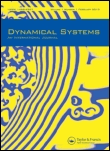
DYNAMICAL SYSTEMS-AN INTERNATIONAL JOURNAL
Fostering Interdisciplinary Insights in Mathematics and ComputingDynamical Systems - An International Journal, published by Taylor & Francis Ltd, serves as a vital resource in the fields of mathematics and computer science applications. With an ISSN of 1468-9367 and E-ISSN 1468-9375, this journal has established a significant presence since its inception in 1996 and continues to contribute valuable insights through 2024. Although it holds a Q3 ranking in both Computer Science Applications and Mathematics (miscellaneous), it is a platform for disseminating innovative research and applications relating to dynamical systems analysis and theory. Despite recent challenges reflected in its Scopus rankings, with percentiles at the 30th and 10th for general mathematics and computer science applications respectively, the journal remains committed to fostering interdisciplinary perspectives and providing a forum for the exchange of ideas among academics, professionals, and students. Open access options ensure that research findings reach a broader audience, enhancing the journal's impact and relevance in a rapidly evolving field.

Journal of Dynamical Systems and Geometric Theories
Bridging Theory and Application in MathematicsJournal of Dynamical Systems and Geometric Theories, published by TARU Publications, is a prominent platform dedicated to advancing knowledge in the fields of dynamical systems and geometric theories. With an ISSN of 1726-037X and an E-ISSN of 2169-0057, this journal serves as a vital resource for researchers, professionals, and students who are keen on exploring the complexities of mathematical models and their applications in various scientific disciplines. Though currently listed as non-open access, the journal provides robust, peer-reviewed content that is essential for fostering innovative research and development. Situated in New Delhi, India, the Journal of Dynamical Systems and Geometric Theories is committed to disseminating high-quality scholarly articles that address both theoretical and practical issues related to dynamical systems, enhancing understanding and stimulating further academic discourse. To learn more about submission guidelines and access options, please visit the journal’s official webpage.

Electronic Journal of Differential Equations
Unlocking the power of differential equations for all.The Electronic Journal of Differential Equations, published by Texas State University, is a premier open-access platform dedicated to the dissemination of high-quality research in the field of differential equations. Established in 1993, this journal not only promotes the accessibility of mathematical research but also fosters a collaborative approach to innovation and discovery within the mathematical community. With an impressive converged publication record from 1996 to 2024, it serves as a vital resource for researchers, professionals, and students alike, showcasing significant contributions to the discipline. Highlighted in the 2023 Scopus ranking, the journal stands in the Q3 category for Analysis with a current rank of #120 among 193 journals, placing it in the 38th percentile. The journal's commitment to open access ensures that groundbreaking findings are freely available to all, thereby enhancing its impact and reach in the ever-evolving landscape of mathematical analysis.

Communications on Applied Mathematics and Computation
Exploring New Horizons in Applied and Computational MathematicsCommunications on Applied Mathematics and Computation is a distinguished journal published by SpringerNature, dedicated to advancing the fields of Applied Mathematics and Computational Mathematics. With its ISSN 2096-6385 and E-ISSN 2661-8893, the journal has established itself as a critical platform for researchers seeking to disseminate their findings and engage with contemporary mathematical challenges. Recognized in the Q2 quartile of both Applied Mathematics and Computational Mathematics categories for 2023, it ranks impressively within its field, holding the 278th position in a pool of 635 journals for Applied Mathematics and the 89th out of 189 for Computational Mathematics, indicative of its scholarly impact. The journal facilitates open access to a plethora of pioneering research, promoting collaboration and innovation in a global academic community. With a commitment to high-quality publications from 2019 through 2024, Communications on Applied Mathematics and Computation serves as an essential resource for scholars and practitioners aiming to bridge theory and practical applications in mathematics.